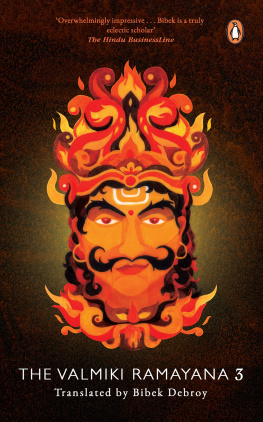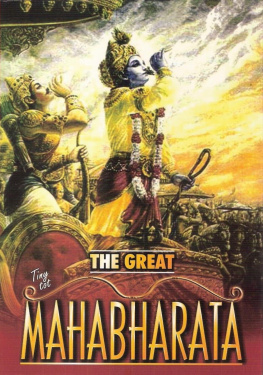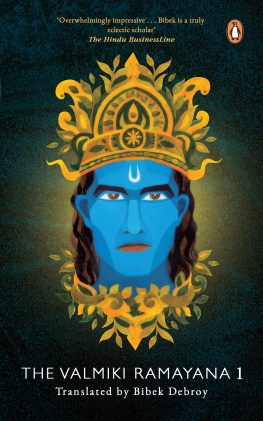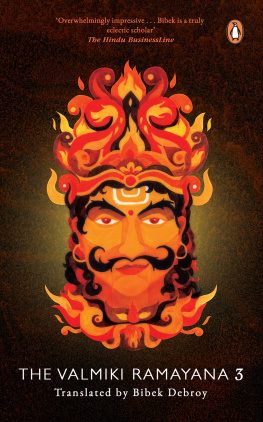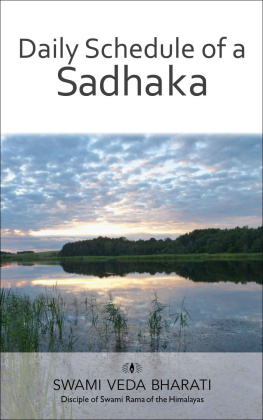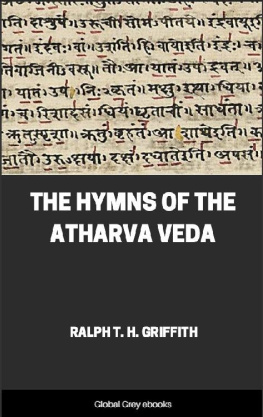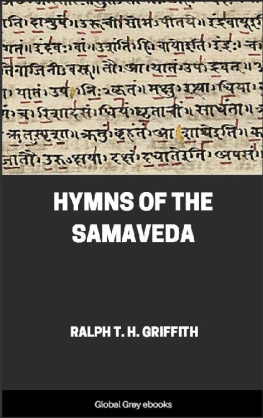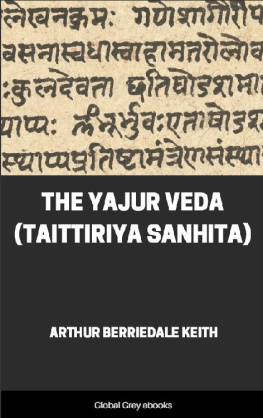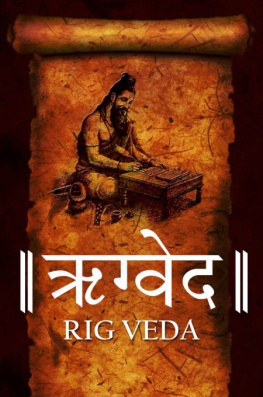Great Epics of India: Vedas
The Rig Veda
Bibek Debroy
Dipavali Debroy
Books For All
(An Imprint of Low Price Publications)
Delhi
Publisher
All rights, including the right to translate or to reproduce this book or parts thereof are reserved.
Published by
Books For All
(An Imprint of Low Price Publications)
A-6, 2 nd Floor, Nimri Commercial Centre,
Ashok Vihar Phase 4, Delhi 110052 (INDIA)
tel.: +91-11-27302453 fax.: +91-11-47061936
e-mail: info@LPPindia.com
website: www.LPPindia.com
Introduction
The Vedas are ancient texts that are sacred in India and renowned the world over. The word veda literally means knowledge. The root is vid, to know. The Vedas are thus texts that provide knowledge.
There are four Vedas, known as the Rig Veda, the Yajur Veda, the Sama Veda and the Atharva Veda. Many years ago, the Vedas were referred to as trayi or three. There must have been some point of time when there were only three Vedas. These are acknowledged to have been the Rig Veda, the Yajur Veda and the Sama Veda. The Atharva Veda is believed to have been a later addition to the sacred canon.
Each of the Vedas has two parts, a samhita and the brahmanas. The samhita part consists of mantras or incantations. These were hymns that were used in sacrifices. But these mantras are difficult to interpret without commentaries. This is what the brahmanas set out to do. They explain the hymns and indicate how these are to be used in sacrifices. The brahmanas also have detailed descriptions of sacrifices and how they are to be conducted. The samhitas and the brahmanas are often known as karma kanda, that is, the part of the Vedas that deals with rituals.
In addition, Vedic literature also includes jnana kanda. This is the part that deals with supreme knowledge. Included in jnana kanda are the aranyakas and the upanishads. These are identified with various Vedas.
We can therefore have a narrow definition of a Veda as well as a broad one. The narrow definition would take the word Veda to mean the samhita alone. The broad definition would include, in addition, associated brahmanas, aranyakas and upanishads. By the word Veda, here we mean the samhita alone. That is, when we are retelling the Rig Veda, we are retelling the Rig Veda Samhita.
When were the Vedas composed and who composed them? Strictly speaking, there is no answer to these questions. The Vedas were revealed; they were shrutis. They were not written down or composed. They were communicated by the supreme godhead or the divine essence ( brahman) to the ancient seers ( rishis ). These rishis did not compose the Vedas; they merely obtained this divine knowledge through their extraordinary powers. In this sense, the Vedas are apourusheya. Their authorship cannot be ascribed to any human author.
Just as it is impossible to determine who composed the Vedas, it is also impossible to determine when they were composed. Widely different dates have been suggested by scholars. Tilak suggested a date of around 6000 B.C., while Jacobis date was around 4500 B.C. Most scholars would agree that the Vedas were compiled sometime between 4000 B.C. and 1000 B.C. and that it is impossible to narrow down the range further. The earliest of the Vedas is clearly the Rig Veda. This reached a stage of final compilation between 1000 B.C. and 900 B.C.
The Rig Veda Samhita
It is first important to understand that there were four classes of priests who were required at any sacrifice, or yajna. The first class consisted of the officiating priests or acolytes ( hotri). They invoked the gods by reciting the mantras, prepared the sacrificial ground and the altar, and poured out the libations. The hymns of the Rig Veda are for this class of priests. The second class of priests consisted of the choristers ( udgatri ). These were the ones who chanted the sacred hymns and the hymns of the Sama Veda are for this class of priests. The third class of priests consisted of the reciters ( adhvaryu ). They carried out sacrificial rites while chanting the sacred texts and the hymns of the Yajur Veda are for this class of priests. The fourth class of priests consisted of brahmana overseers. They supervised the sacrifice and the hymns of the Atharva Veda are for this class of priests.
The Rig Veda derives its name from the word rik, which means a mantra. There are 10,589 verses in the Rig Veda Samhita. These are divided into ten mandalas or books. Each of the mandalas is subdivided into anuvakas (lessons) and suktas (hymns). The ten mandalas have 85 anuvakas, 1080 suktas and 10,589 verses. There is also a valakhilya section or supplement. This seems to have been a later addition.
Let us now see what the Rig Veda has to say. Since the Rig Veda is fairly long, we will have to be selective. We cannot be exhaustive.
Mandala One
(This mandala has 181 suktas and 2006 mantras. The bulk of the mantras are addressed to Indra. Agni comes next in order of importance.)
Agni
(Agni is the fire-god. It is to Agni that oblations in a sacrifice are offered. Agni is regarded as a messenger who summons the other gods to the sacrifice and carries the offerings to them. This particular hymn is ascribed to a sage named Madhuchhanda Vaishvamitra. He was descended from the famous sage Vishvamitra. Various hymns follow various metres and this one is in the gayatri metre.)
I pray to Agni. He advances to the front so that he can bring about the welfare of men. It is Agni who makes the sacrifice a success. This is a sacrifice that is being performed according to the rites of the season. Agni is the prosperous one. He will summon the gods to this sacrifice.
Agni has been praised by many sages of earlier times. He is being praised by the sages who are here now. May Agni bring the gods to this sacrifice.
Every day, men will obtain nourishment from Agni. They will certainly obtain fame, valour and riches.
O Agni! This is a non-violent sacrifice that is being performed. Make it successful from every direction. May we be able to attain the proximity of the gods.
You are the one who will summon the gods. You are the one who will ensure that the sacrifice is successfully completed. You are the one who inspires learned men to action. O Agni! Many are your forms and you are always truthful. You are the radiant one who has performed wonderous deeds. Agni has come to the sacrifice with the other gods.
O my beloved Agni! You ensure the welfare of those who give alms. You are the one who is present in every portion of our anatomy. The acts you perform are the ones that are truly righteous.
O Agni! We pray to you always, night and day. May we use our intelligence to come close to you.
You are the radiant one. You are the protector of non-violent sacrifices. You are the one who manifests the immutable truth. We bow in obeisance before Agni and come close to him. He will make our houses prosper.
O Agni! You are the famous one. We are like your sons; be like a father unto us. Grant us happiness and ensure our welfare. Aid us in our endeavours.
Vayu
(Vayu is the god of the wind. This hymn is also ascribed to the sage Madhuchhanda Vaishvamitra. And this too, is in the gayatri metre.)
O Vayu! You are the one who is fit to be seen. Come here. This soma juice has been prepared for you. Drink the soma juice and listen to our prayers.
O Vayu! The learned priests are well-versed in the knowledge of which days are auspicious and which are not. They have prepared the soma juice on an auspicious day. The choristers are singing your praise through their hymns.
O Vayu! These great words are being addressed to you. You are the great one. You are the one who grants boons. We desire that you may drink this soma juice.
O Indra! O Vayu! This is soma juice that has been prepared. Take great care in coming here. This soma juice wishes to be united with you.
Next page

